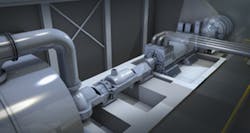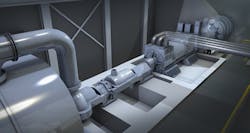Q: How has the process of steam management and monitoring evolved over the past 10 to 20 years?
A: In the 1980s and 1990s the steam management and monitoring process was about digital automation. This was a step change as customers were able to move from pneumatic and analog controls to gather digital data, while addressing human factors and doing more with less. In the 2000s the process began to evolve with a focus on plant and fuel optimization, above the basic digital automation. This plant level optimization allowed multiple end-users to produce incremental peak power during the summers of 1999 and 2000. Having few incremental MW available proved very lucrative in both the regulated and deregulated market.
Today, the process is about using data to plan operational and maintenance activities—whether that be daily, weekly or yearly. In addition, real-time data is used to communicate to leadership how to run their plant more efficiently and support peak or standby opportunities. This process evolved not only with the availability of more actionable data, but also due to the fact that many plants operate in a de-regulated market.
A: The primary focus has been automation and optimization of heat rate and plant systems (blending coal, running pulverizes, etc.). With pneumatic and analog systems performing the tuning, plant optimization required equipment device calibration frequently to address thermal drift, timer lags, feedback overshoots and pneumatic fowling.
READ ALSO: Understanding the Impact of Steam Cleanout on Thermowell Installations
Digital technology has eliminated the pneumatic and analog tuning issues that traditionally had caused plant degradation. Now, we’re seeing the use of smart data in a diagnostic role, which provides significant benefits to plant operations and maintenance activities. No longer are devices simply on or off, but they provide more value due to having data signatures for analysis. Steam operators can harness the power of Industrial Internet that uses smart devices that provide critical and operational information to use for online tuning and analytics. We can also leverage modern steam turbine technology to retrofit the flow path of old steam turbines for higher efficiency and capacity.
Q: In your experience with customers, where do you see opportunities most often being missed regarding steam management & monitoring?
A: Providers of combustion turbines, heat recovery steam generator (HRSG) and steam turbines are often different, which means further optimization can be achieved beyond contractual EPC performance requirements. Providing better coordination with the equipment could provide better efficiencies in startup, emissions, heat rate and power output.
There is also a need for utilizing advanced condition signature monitoring tools. These diagnostic tools can help customers identify potential issues in the boiler, turbine-generator or pump that would lead to significant unplanned downtime.
Q: What are some examples of end-user applications where novel methods for steam management and monitoring are being utilized to produce a major impact on the bottom line?
A: Overall, we’re seeing the use of integrated operational and management tools that improve plant performance, operator frontline decision-making and maintenance planning. These tools also drive regulatory reporting and emission compliance by using advance predictive software in closed-loop control to drive set-point changes for operation.
Other operational tools becoming more common are steam alarm management for operator productivity and HMI graphical human factors structuring to reduce misinterpretation and fatigue. The result of all these changes is more steam being produced, more power to the grid and less maintenance downtime required. All of these things combined with system enhancements increase the overall system reliability.
Q: How do you see the process of steam management and monitoring evolving in the years to come? How will the technology and systems for steam management and monitoring be better tomorrow than they are today?
A: I would break this down into the three markets: Nuclear, Fossil and Combined Cycle.
For Nuclear, the focus is just automation. Nuclear power producers tend to be slower adopters of new technology, but their push for automation will result in the reduction of human factors (potential errors) and will bring simplification in procedural writing and administering oversight. This allows for the future of digital information to improve plant operations.
For Fossil, the market is mature and right sizing. We’re seeing more large-scale, supercritical units being built in emerging countries like China and India. There are opportunities for performance and maintenance improvement through boiler technologies to provide operational flexibility and improved equipment life.
For Combined Cycle, the market is expanding with the growth of natural gas (fracking) technologies and renewables. The ability to control operational performance, both human and equipment, will be key aspects to how these new CC plants make money in regulated and degraded markets.
Interview conducted by Matt Migliore, Flow Control’s director of content. Reach Matt at [email protected].




